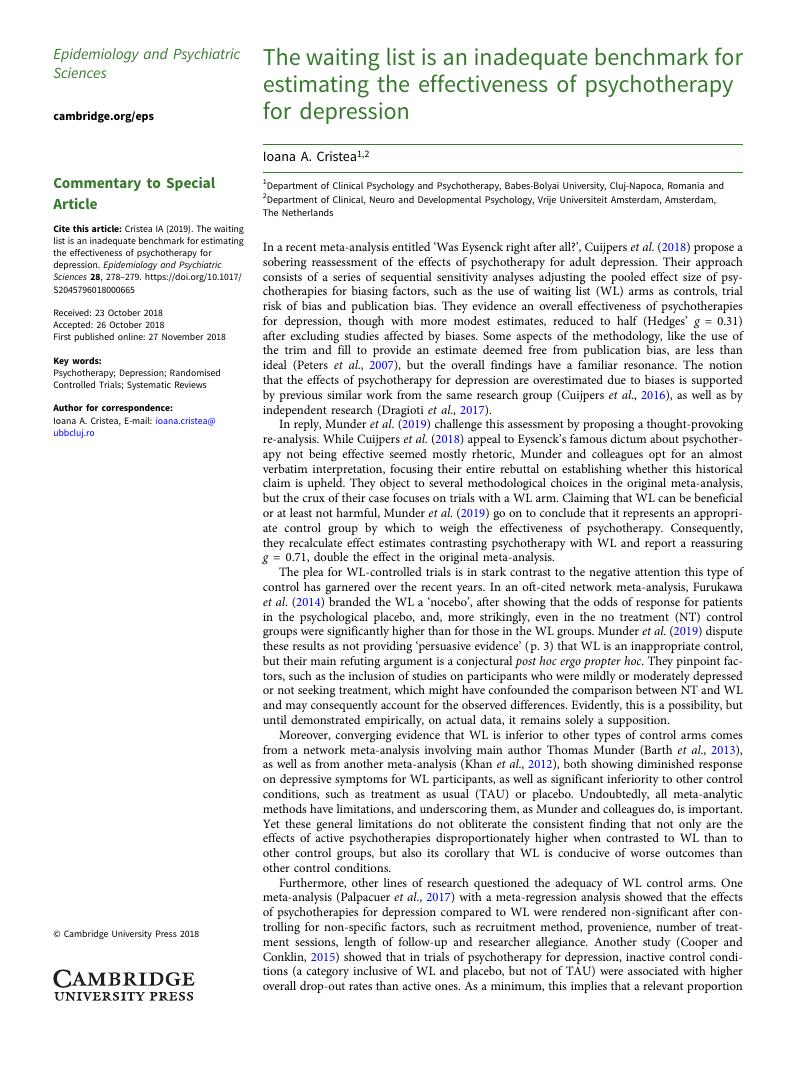Crossref Citations
This article has been cited by the following publications. This list is generated based on data provided by Crossref.
Linardon, Jake
Cuijpers, Pim
Carlbring, Per
Messer, Mariel
and
Fuller‐Tyszkiewicz, Matthew
2019.
The efficacy of app‐supported smartphone interventions for mental health problems: a meta‐analysis of randomized controlled trials.
World Psychiatry,
Vol. 18,
Issue. 3,
p.
325.
Munder, Thomas
Flückiger, Christoph
Leichsenring, Falk
Abbass, Allan A.
Hilsenroth, Mark J.
Luyten, Patrick
Rabung, Sven
Steinert, Christiane
and
Wampold, Bruce E.
2019.
Let’s Distinguish Relative and Absolute Efficacy to Move Psychotherapy Research Forward.
Zeitschrift für Psychosomatische Medizin und Psychotherapie,
Vol. 65,
Issue. 2,
p.
178.
Barbui, Corrado
Purgato, Marianna
Abdulmalik, Jibril
Acarturk, Ceren
Eaton, Julian
Gastaldon, Chiara
Gureje, Oye
Hanlon, Charlotte
Jordans, Mark
Lund, Crick
Nosè, Michela
Ostuzzi, Giovanni
Papola, Davide
Tedeschi, Federico
Tol, Wietse
Turrini, Giulia
Patel, Vikram
and
Thornicroft, Graham
2020.
Efficacy of psychosocial interventions for mental health outcomes in low-income and middle-income countries: an umbrella review.
The Lancet Psychiatry,
Vol. 7,
Issue. 2,
p.
162.
Fodor, Liviu A
Georgescu, Raluca
Cuijpers, Pim
Szamoskozi, Ştefan
David, Daniel
Furukawa, Toshiaki A
and
Cristea, Ioana A
2020.
Efficacy of cognitive bias modification interventions in anxiety and depressive disorders: a systematic review and network meta-analysis.
The Lancet Psychiatry,
Vol. 7,
Issue. 6,
p.
506.
Viol, Kathrin
Schiepek, Günter
Kronbichler, Martin
Hartl, Arnulf
Grafetstätter, Carina
Strasser, Peter
Kastinger, Anna
Schöller, Helmut
Reiter, Eva-Maria
Said-Yürekli, Sarah
Kronbichler, Lisa
Kravanja-Spannberger, Brigitte
Stöger-Schmidinger, Barbara
Hütt, Marc-Thorsten
Aichhorn, Wolfgang
and
Aas, Benjamin
2020.
Multi-level assessment of obsessive-compulsive disorder (OCD) reveals relations between neural and neurochemical levels.
BMC Psychiatry,
Vol. 20,
Issue. 1,
Gál, Éva
Ștefan, Simona
and
Cristea, Ioana A.
2021.
The efficacy of mindfulness meditation apps in enhancing users’ well-being and mental health related outcomes: a meta-analysis of randomized controlled trials.
Journal of Affective Disorders,
Vol. 279,
Issue. ,
p.
131.
Reis, Dorota
and
Meier, Laurenz L.
2021.
Handbuch Gesundheitsförderung bei der Arbeit.
p.
1.
Cuijpers, Pim
Quero, Soledad
Papola, Davide
Cristea, Ioana A.
and
Karyotaki, Eirini
2021.
Care-as-usual control groups across different settings in randomized trials on psychotherapy for adult depression: a meta-analysis.
Psychological Medicine,
Vol. 51,
Issue. 4,
p.
634.
Blackwell, Simon E
and
Woud, Marcella L
2022.
Making the leap: From experimental psychopathology to clinical trials.
Journal of Experimental Psychopathology,
Vol. 13,
Issue. 1,
p.
204380872210800.
Reis, Dorota
and
Meier, Laurenz L.
2022.
Handbuch Gesundheitsförderung bei der Arbeit.
p.
371.
Fineberg, Naomi A.
Pellegrini, Luca
Clarke, Aaron
Perera, Uday
Drummond, Lynne M.
Albert, Umberto
and
Laws, Keith R.
2022.
Meta-analysis of cognitive behaviour therapy and selective serotonin reuptake inhibitors for the treatment of hypochondriasis: Implications for trial design.
Comprehensive Psychiatry,
Vol. 118,
Issue. ,
p.
152334.
Kaiser, Tim
Brakemeier, Eva-Lotta
and
Herzog, Philipp
2023.
What if we wait? Using synthetic waiting lists to estimate treatment effects in routine outcome data.
Psychotherapy Research,
Vol. 33,
Issue. 8,
p.
1043.
Bhattacharya, Shalini
Goicoechea, Carmen
Heshmati, Saeideh
Carpenter, Joseph K.
and
Hofmann, Stefan G.
2023.
Efficacy of Cognitive Behavioral Therapy for Anxiety-Related Disorders: A Meta-Analysis of Recent Literature.
Current Psychiatry Reports,
Vol. 25,
Issue. 1,
p.
19.
Davis, Rebecca S.
Meiser-Stedman, Richard
Afzal, Nimrah
Devaney, John
Halligan, Sarah L.
Lofthouse, Katie
Smith, Patrick
Stallard, Paul
Ye, Siyan
and
Hiller, Rachel M.
2023.
Systematic Review and Meta-analysis: Group-Based Interventions for Treating Posttraumatic Stress Symptoms in Children and Adolescents.
Journal of the American Academy of Child & Adolescent Psychiatry,
Vol. 62,
Issue. 11,
p.
1217.
Pettman, Danelle
O’Mahen, Heather
Blomberg, Oscar
Svanberg, Agneta Skoog
von Essen, Louise
and
Woodford, Joanne
2023.
Effectiveness of cognitive behavioural therapy-based interventions for maternal perinatal depression: a systematic review and meta-analysis.
BMC Psychiatry,
Vol. 23,
Issue. 1,
Smith, Martin M.
and
Hewitt, Paul L.
2024.
The equivalence of psychodynamic therapy and cognitive behavioral therapy for depressive disorders in adults: A meta‐analytic review.
Journal of Clinical Psychology,
Vol. 80,
Issue. 5,
p.
945.






Target article
Was Eysenck right after all? A reassessment of the effects of psychotherapy for adult depression
Related commentaries (1)
The waiting list is an inadequate benchmark for estimating the effectiveness of psychotherapy for depression